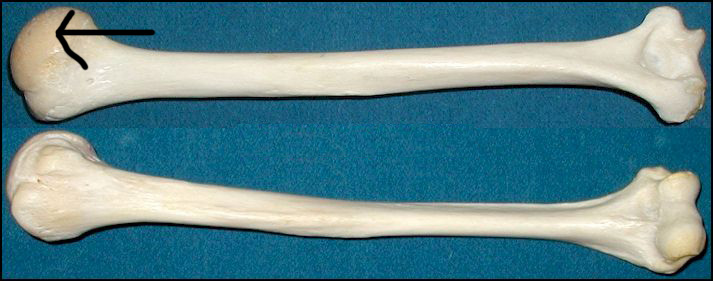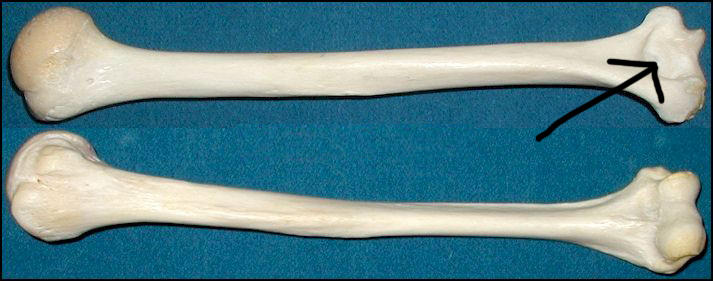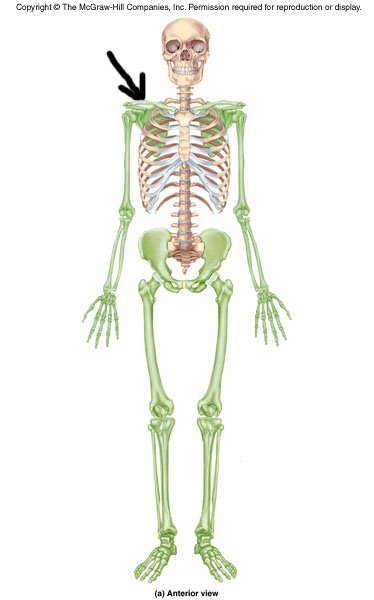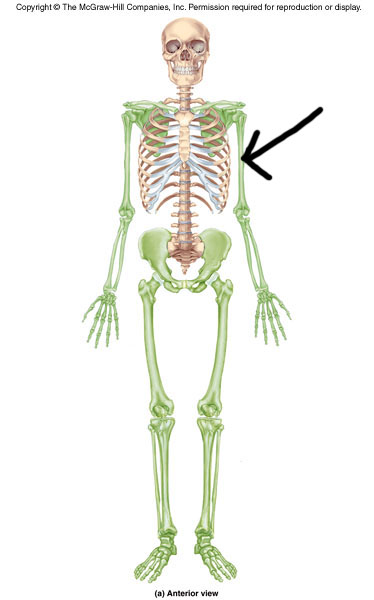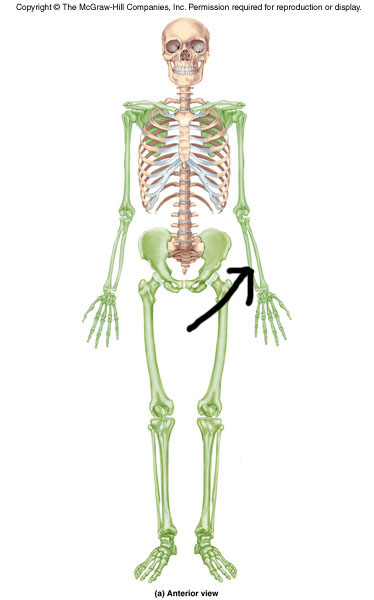Skeletal Lab Practice Exam Quiz!

.
Questions and Answers
- 1.
Name this part of this bone.
Explanation
The correct answer is "capitulum." The capitulum is a part of a bone, although it is not specified which bone in the question. It is a rounded, knob-like structure that forms a joint with another bone.Rate this question:
- 2.
Name this part of this bone.
Explanation
The deltoid tuberosity is a bony prominence located on the lateral side of the humerus bone. It serves as the attachment site for the deltoid muscle, which is responsible for shoulder abduction and flexion. The term "tuberosity" refers to a roughened area on a bone where tendons or ligaments attach. In this case, the deltoid tuberosity provides stability and strength to the shoulder joint by anchoring the powerful deltoid muscle.Rate this question:
- 3.
Name this part of this bone.
Explanation
The greater tubercle refers to a specific part of the humerus bone. It is a prominent projection located on the lateral side of the bone, near the head of the humerus. This structure serves as an attachment site for various muscles and tendons, including the supraspinatus, infraspinatus, and teres minor muscles. The greater tubercle of the humerus plays a crucial role in the movement and stability of the shoulder joint.Rate this question:
- 4.
Name this part of this bone.
Explanation
The given answer includes four different parts of the bone: head, epiphysis, hyaline cartilage, and head of humerus. The head refers to the rounded end of the bone, while the epiphysis is the wider section at the end of the bone. Hyaline cartilage is a type of connective tissue that covers the surface of the bone, providing cushioning and reducing friction. Lastly, the head of the humerus specifically refers to the rounded end of the upper arm bone.Rate this question:
- 5.
Name this part of this bone.
Explanation
The given answer "lateral epicondyle, lateral epicondyle of humerus" correctly identifies the part of the bone being referred to. The lateral epicondyle is a bony prominence located on the outer side of the humerus bone, specifically on the distal end. It serves as an attachment point for various muscles and ligaments, including those involved in the movement of the forearm and wrist.Rate this question:
- 6.
Name this part of this bone.
Explanation
The correct answer is "lesser tubercle" or "lesser tubercle of humerus". The lesser tubercle is a bony prominence located on the anterior surface of the humerus bone. It serves as an attachment site for muscles and ligaments, including the subscapularis muscle of the rotator cuff. The term "lesser tubercle of humerus" specifically refers to this bony prominence in relation to the humerus bone.Rate this question:
- 7.
Name this part of this bone.
Explanation
The correct answer is "medial epicondyle of humerus, medial epicondyle." The medial epicondyle is a bony prominence located on the inner side of the humerus bone in the upper arm. It serves as an attachment point for various muscles and ligaments, including those involved in flexing and pronating the forearm. The term "medial" indicates its position towards the midline of the body, while "epicondyle" refers to its location above the condyle of the humerus bone.Rate this question:
- 8.
- 9.
Name this part of this bone.
Explanation
The olecranon fossa is a part of the bone called the olecranon. It is a depression located at the back of the humerus bone in the elbow joint. The olecranon fossa serves as a space for the olecranon process of the ulna bone to fit into when the arm is extended. This allows for smooth movement and stability of the elbow joint.Rate this question:
- 10.
Name the bone(s).
Explanation
The correct answer is carpals. Carpals are a group of small bones located in the wrist area. They are arranged in two rows and form the structure of the wrist joint. The carpals provide flexibility and stability to the wrist, allowing for various movements of the hand and fingers.Rate this question:
- 11.
Name the bone(s).
Explanation
The bone being referred to in this question is the clavicle. The clavicle, also known as the collarbone, is a long, slender bone that connects the shoulder blade to the sternum. It is easily identifiable due to its S-shape and is located in the upper chest area. The clavicle plays a crucial role in providing stability and support to the shoulder joint, allowing for a wide range of arm movements.Rate this question:
- 12.
Name the bone(s).
Explanation
The bone being referred to in this question is the humerus. The humerus is the long bone located in the upper arm, between the shoulder and the elbow. It is the largest bone in the arm and plays a crucial role in the movement and stability of the arm.Rate this question:
- 13.
Name the bone(s).
Explanation
The correct answer is "metacarpals." The metacarpals are the bones located in the palm of the hand, connecting the fingers to the wrist. There are five metacarpal bones in each hand, numbered from one to five, starting from the thumb side. These bones play a crucial role in allowing movement and flexibility in the hand, enabling us to grasp and manipulate objects.Rate this question:
- 14.
Name the bone(s).
Explanation
The bone(s) that are being referred to in this question are called phalanges. Phalanges are the bones that make up the fingers and toes. They are long, slender bones that are connected to the metacarpals in the hands and the metatarsals in the feet. Each finger and toe has three phalanges, except for the thumb and big toe which only have two. The phalanges play a crucial role in allowing us to grasp and manipulate objects, as well as providing support and balance while walking or running.Rate this question:
- 15.
Name the bone(s).
Explanation
The correct answer is "radius." The radius is one of the two bones in the forearm, along with the ulna. It is located on the thumb side of the forearm and runs parallel to the ulna. The radius plays a crucial role in forearm rotation and in the movement of the wrist and hand.Rate this question:
- 16.
- 17.
What bone is this? Is it left or right? Answer by typing "side bone" - ex. "right humerus".
Explanation
The given answer, "left scapula," correctly identifies the bone in question as the scapula and specifies that it is on the left side. The scapula, also known as the shoulder blade, is a flat triangular bone that connects the upper arm bone (humerus) to the collarbone (clavicle). By stating "left scapula," it indicates that the bone being referred to is specifically on the left side of the body.Rate this question:
Quiz Review Timeline +
Our quizzes are rigorously reviewed, monitored and continuously updated by our expert board to maintain accuracy, relevance, and timeliness.
-
Current Version
-
Mar 22, 2023Quiz Edited by
ProProfs Editorial Team -
Oct 04, 2009Quiz Created by
Shelleyr
- Accreditation Quizzes
- Advanced Placement Quizzes
- AED Exam Quizzes
- Art Exam Quizzes
- Banking Exam Quizzes
- BISC Exam Quizzes
- CADET Exam Quizzes
- CAE Listening Quizzes
- CHS Exam Quizzes
- Computer Operator Exam Quizzes
- Cosmetology State Board Quizzes
- CSAT Quizzes
- CVS Exam Quizzes
- EHR Exam Quizzes
- English Exam Quizzes
- Entrance Exam Quizzes
- FSHN Exam Quizzes
- GATE Quizzes
- IGCSE Quizzes
- JEE Exam Quizzes
- Ministerial Exam Quizzes
- OCA Exam Quizzes
- Online Test Quizzes
- Physical Exam Quizzes
- Police Exam Quizzes
- Prelim Exam Quizzes
- SNAP Quizzes
- SSC Quizzes
- SSC CGL Quizzes
- UGC NET Exam Quizzes
- UPSC Quizzes
 Back to top
Back to top






